Swarming divers and turtles in competition for food
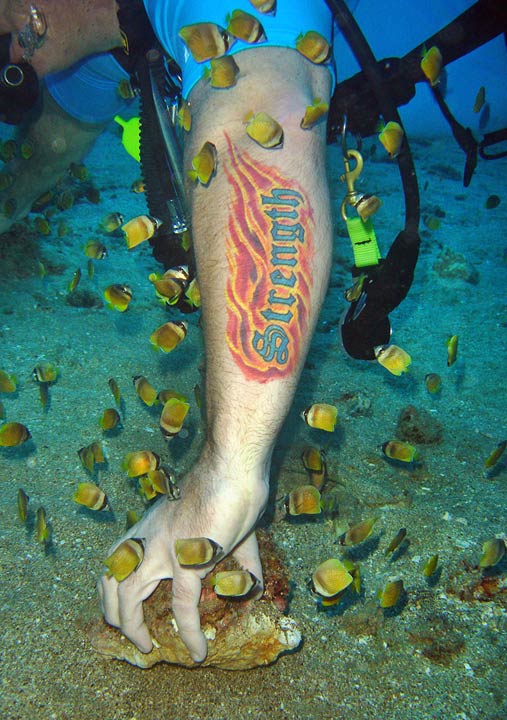
The arm of Ed Fingers gets picked by juvenile Blacklip Butterflyfish. Puu olai, Maui. Aug. 27, 2014
Strength in numbers is not a phrase that applies to the recent settlement of estimated millions of Blacklip Butterflyfish (Chaetodon kleinii) at Molokini and off the south coast of Maui. This many fish compete mightily for the limited amount of available food. We didn’t realize how serious the competition was until we had the opportunity to observe these masses of fish in two completely different habitats separated by 3 miles.
Molokini is a little volcanic cone that sits 3 miles off the coast of Maui in about 300 feet of water. Because it is so far offshore it is often exposed to currents and sometimes upwellings, both of which bathe the island in food for plankton-eating fish and invertebrates. Thus, the estimated millions of Blacklip Butterflyfish that settled at Molokini in July and August and September of this year (see Sept. 2 blog post) have been well-provided for by virtue of Molokini’s geographical position. They have distributed themselves roughly evenly around the crater, finding habitat all around it, and feed by picking the abundant plankton out of the water a few feet from the protection of cracks and crevices in the rock and reef.
The Blacklip Butterflyfish that settled along the coastline of Maui, however, have not been able to distribute themselves evenly because much of the bottom is flat, open sand. The sand provides no shelter so they have been forced to congregate over the isolated rocks and reefs. In addition, these Maui areas do not receive as much current, and therefore planktonic food items, as does Molokini. Such high concentrations of fish mean that competition for the limited plankton around these rocks is fierce. Yes, they are plucking tiny planktonic animals out of the water, but in addition they are performing a behavior that is very unusual for fish – juvenile or adult. They are swarming over us, picking who-knows-what off any exposed skin, dive gear and camera equipment.
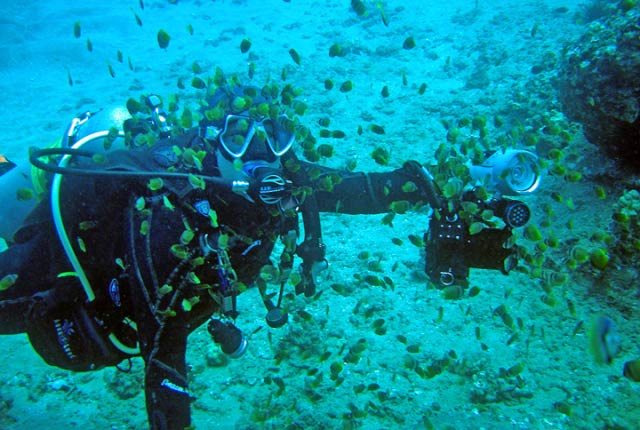
Victoria Martocci is swarmed by juvenile Blacklip Butterflyfish. Puu olai, Maui. Aug. 27, 2014.
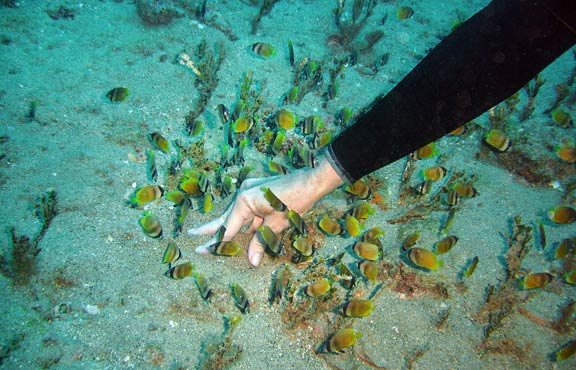 If you remember the old (and effective) Johnson’s Wax TV commercial for OFF mosquito repellent you will be able to picture what diving during this time has been like. In the commercial when the man puts his untreated arm into the terrarium of mosquitos they immediately swarm his arm. This has been the scenario at certain rocks off of Maui. As soon as we come close enough to the rock these youngsters swarm us, looking for any part of us that might be edible.
If you remember the old (and effective) Johnson’s Wax TV commercial for OFF mosquito repellent you will be able to picture what diving during this time has been like. In the commercial when the man puts his untreated arm into the terrarium of mosquitos they immediately swarm his arm. This has been the scenario at certain rocks off of Maui. As soon as we come close enough to the rock these youngsters swarm us, looking for any part of us that might be edible.
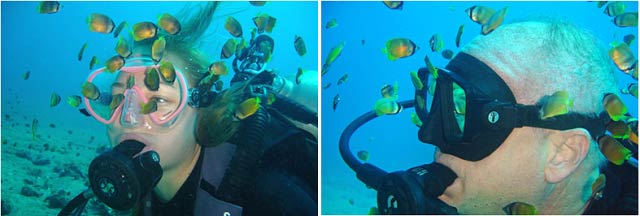
Ann Quinn and JD Brill hold still while juvenile Blacklip Butterflyfish pick at their masks. Puu olai, Maui. Aug. 14, 2014.
Of course, we are not the only visitors to these rocks. Turtles, which are used to receiving some attention from several species of adult fish who clean their shell of algae and organic matter, are swarmed as well.
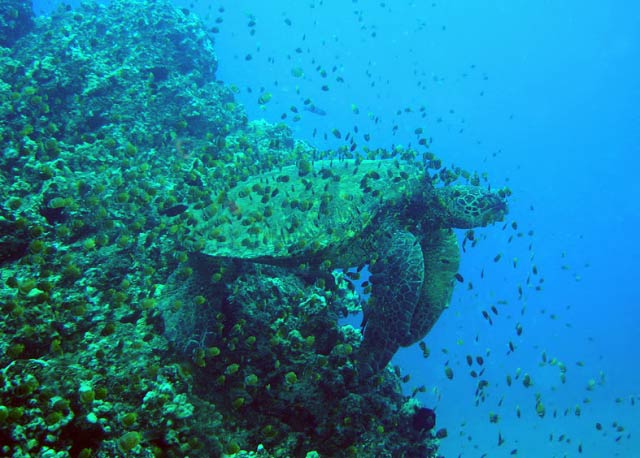
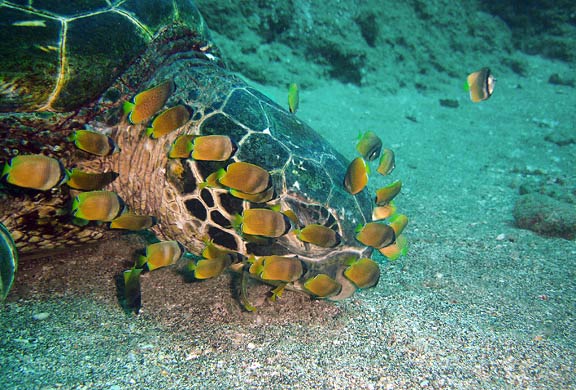 Competition for food drives them to us. The ones that are bolder and more willing to approach large animals such as turtles and divers might be rewarded with more food. But they could also be exposing themselves to greater danger by moving farther away from their shelter. The ones that stay near the rock – perhaps they miss out on a good food source, but they may also be safer from predators. Interestingly, on days when there was current on these rocks, the fish were up in the water feeding and not at all interested in us. The current was presumably bringing them all the food they needed.
Competition for food drives them to us. The ones that are bolder and more willing to approach large animals such as turtles and divers might be rewarded with more food. But they could also be exposing themselves to greater danger by moving farther away from their shelter. The ones that stay near the rock – perhaps they miss out on a good food source, but they may also be safer from predators. Interestingly, on days when there was current on these rocks, the fish were up in the water feeding and not at all interested in us. The current was presumably bringing them all the food they needed.
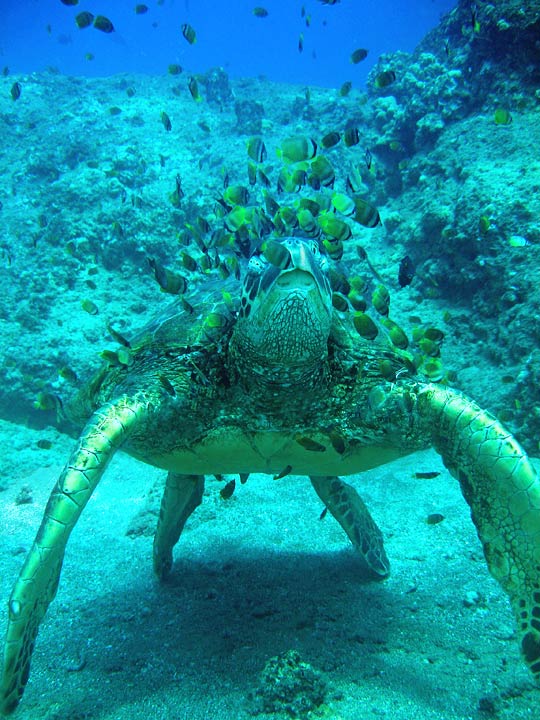
It has been six weeks since they began swarming us and as their numbers decreased, so did the frenzy of unusual behavior. They stopped swarming divers and turtles, perhaps because there was enough food in the water for their reduced numbers. Or, perhaps as they get older, like many animals, they lose the fearless behavior and become more cautious.
While it lasted it was a wonderful experience out of the norm – to have fish coming to us instead of fleeing from us! In 35 years of diving in Hawaii we have never seen swarming behavior like this.
And if you’re wondering what it looked like from the turtle’s perspective….
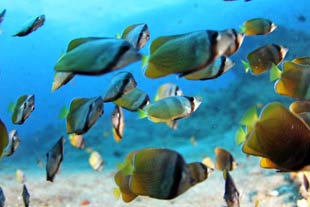
Text and photos by Pauline Fiene
****************
We would be so interested to hear if anyone else has observed behavior like this from a species of reef fish.
****************

Comments 5
Pauline: Yes we’ve seen this before but not in this species. Back in the early 1980’s when the Pervagor spilosoma were swarming we saw and experienced a very similar behavior, including biting our hair. Many of those filefish were extremely emaciated as time went on and I presume died of starvation or were eaten. Great photos by the way! Aloha.
Author
Thanks, Bruce. I have some wonderful accounts of that from people here on Maui too. I am wondering, were the fish that you saw doing that juveniles? And if so, did they continue to do that when they became adults?
Yet another interesting and well written blog! Thanks guys and I loved the turtle shots!!
Great article. It really has been amazing and fun to have these swarms of little butterflies. A few days ago, diving, I thought they looked like confetti sparkling in the sun. So pretty.
Hi Pauline,
Yes, when the Pervagor exploded back in the 80’s they were juveniles. Like Bruce said, after the first week or two they would swarm around anything that moved, looking for food. I remember them picking at my arms and legs and body. Another week or two later, there were millions of carcasses of them drifting on the bottom, a small fraction of which ultimately washed up on the beaches (which is what most people remember). Sadly, I expect that you’ll start seeing the same pattern in these butterflyfishes.
But here is the slightly ominous thing: Before the Pervagor explosion, regular (adult) Pervagor were reasonably common. After the explosion (and die-off), it was years before I saw any adults again, and even more years before they rebounded in numbers. I certainly hope the same doesn’t happen with these butterflyfishes, but if the juveniles are overwhelming the same food source as the adults, it’s possible. And, of course, and other species that relies on that same food source could potentially be in trouble (not to mention whatever species the food source itself is).
I very-much hope this doesn’t happen to butterflyfishes off Maui, but you should certainly monitor things over the next year or two, just to see if you notice this effect.
Aloha,
Rich